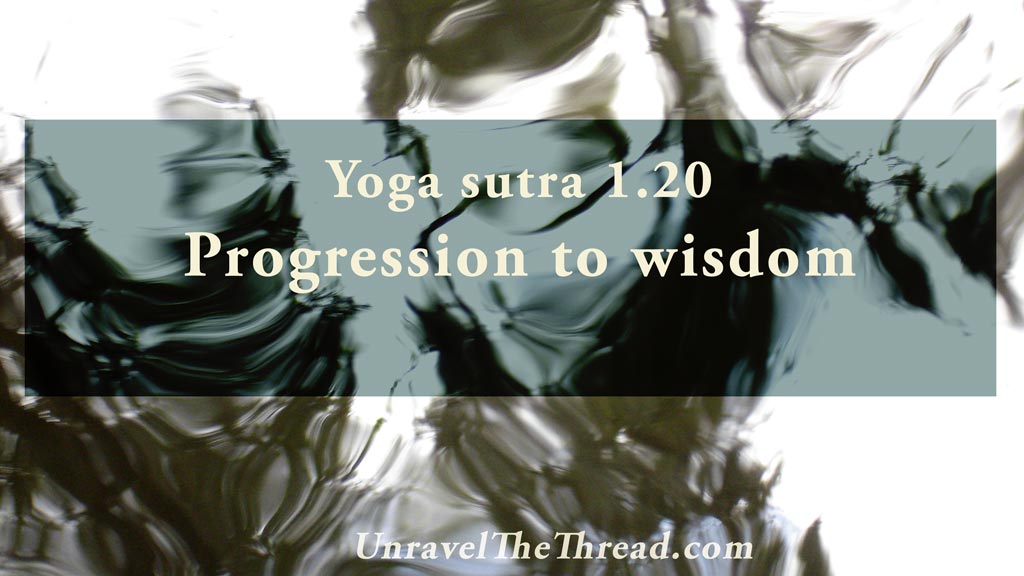
1.19 Beyond subtle integration
August 15, 2019
1.21 and 1.22 Commitment and intensity
September 1, 2019
1.19 Beyond subtle integration
August 15, 2019
1.21 and 1.22 Commitment and intensity
September 1, 20191.20 Progression to wisdom


1.20 Others, rooted on trust and confidence (shraddha), that ignites vitality (virya); and on remembrance (smrti), that steadies their focus; grow into evenness of mind (samadhi) that leads to insight and wisdom (prajña).
This verse presents the alternative pathway toward the higher integration mentioned in the previous three sutras (1.17, 1.18 and 1.19). This is the path for the rest of us. Again, this is a gradual process. It begins with trust and confidence (shraddha). Although the word shraddha is often translated as faith, the connotation of blind belief may be misleading, particularly if it is interpreted as renouncing one’s common sense or capacity for rational thinking. Faith can also be misinterpreted as a call for letting others make one’s own decisions and choices. This sutra calls practitioners to root their practice in trust and confidence that grow out of truth, correct knowledge arising from direct experience, logical inference, and trustworthy testimony (1.7). True knowledge is a source of energy that ignites vitality, passion and enthusiasm (virya). This energy provides sustenance to stay on the path of personal discovery. What you know through your direct experience is easy to remember. Thus, true knowledge acts as a reminder (smrti) to remain steady on the journey and not to lose sight of the goal, embodying full awareness.
Engaging on your path with trust, vitality and memory of your intention creates the ripe conditions for your mind to be calm, steady and growing in inner silence (samadhi). As a result, being less distracted by the coming and going of temporary phenomena, you are better able to notice insight and wisdom all around you (prajña). This insight or intuition manifests as the silent whisper of your heart, or inner guru, guiding your intentions and actions. Thus, you can tune into pure common sense offered by all of life and recognize that your teachers are all around you – and that what used to feel like coincidences are actually synchronicities showing you the deep interconnectedness between all that is.
How are you cultivating your trust and confidence? Are you energized by your life and choices? How are you keeping your intention clear in your mind and actions? What helps you remember your deeply felt intention? Are you noticing a gradual decrease of distractions drawing you away from your objectives? Is there slightly more evenness of mind? Are you willing to trust the subtle guidance you receive in your daily interactions?
One note, the questions in these articles come from my personal process of exploring the yoga sutras as well as from my experience guiding others through this process. However, I’m not asking you to trust that these techniques work. Instead I am inviting you to test them out and see if they work for you. This is the traditional approach in yoga, direct experience. It is your direct experience that helps you decide if this information is useful for you at this time.
As usual, one more way of exploring the meaning of this sutra is by chanting it.
You can choose to chant it in its traditional form with all the words coming together:
1.20 śraddhāvīryasmṛti samādhiprajñāpūrvaka itareṣām
श्रद्धावीर्यस्मृति समाधिप्रज्ञापूर्वक इतरेषाम् ॥२०॥
Another option is to chant each word in the sutra individually:
- śraddhā
- vīrya
- smṛti
- samādhi
- prajñā
- pūrvaka
- itareṣām
Unravel the thread is now available as a book!
If you find Simple-Yoga.org and Unravel the thread useful, consider supporting my labor with a donation, you may also donate using PayPal or Venmo. Thank you!